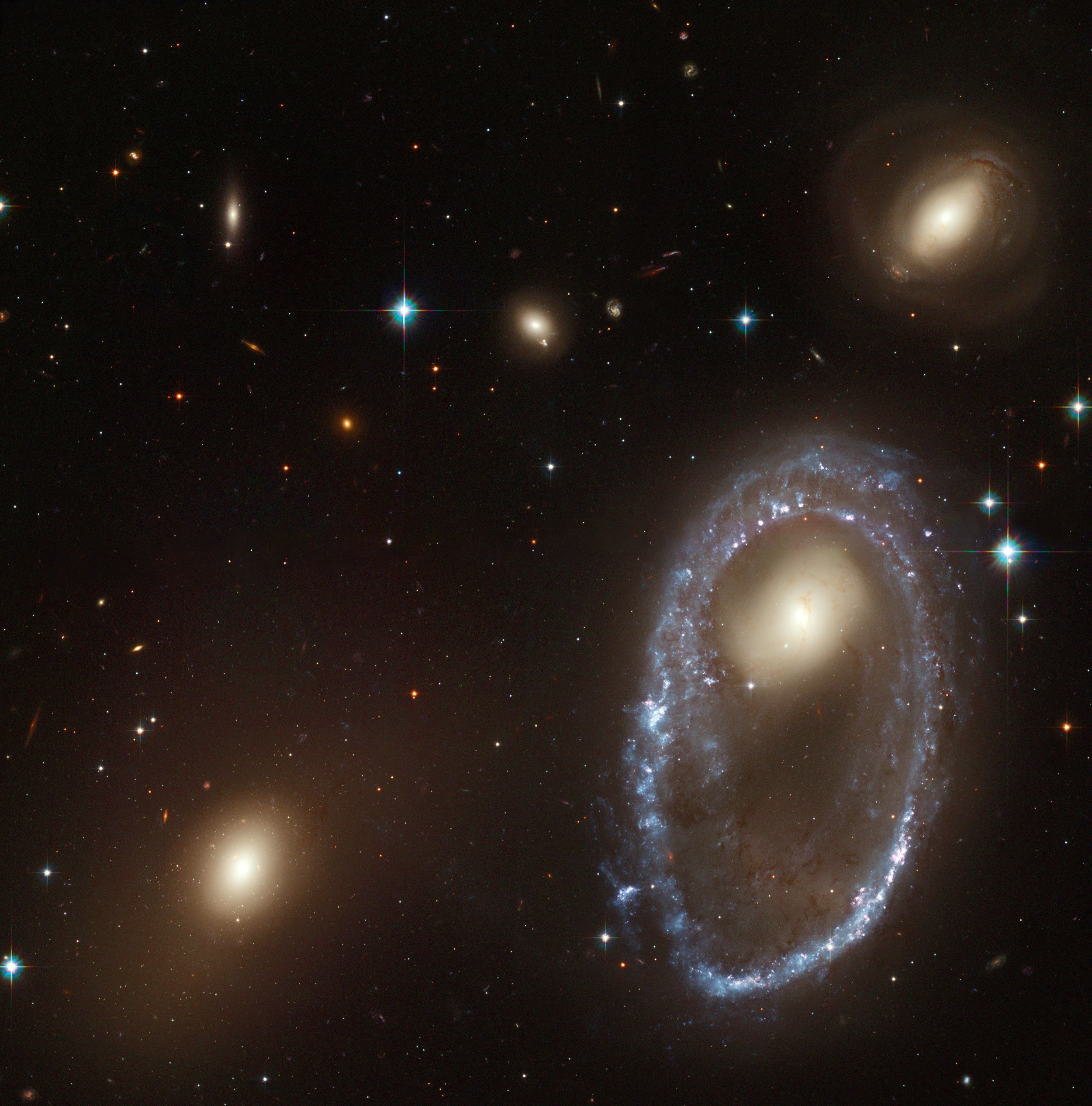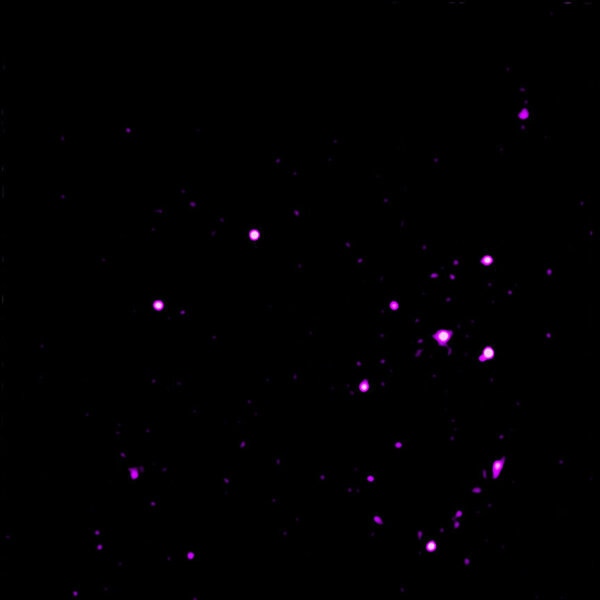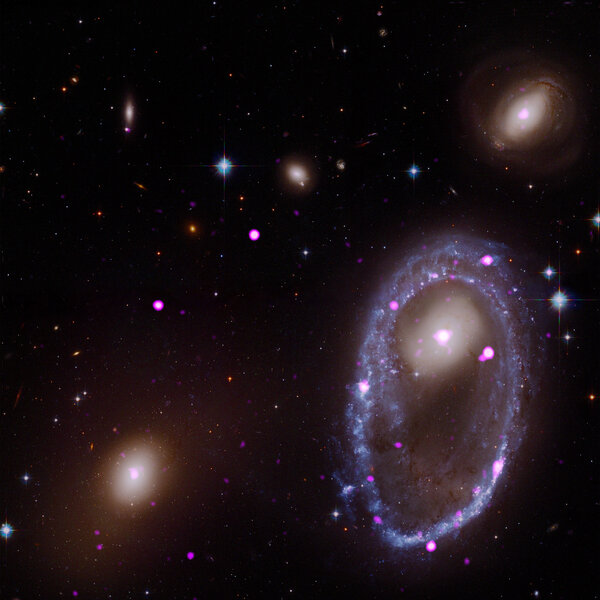Create a free profile to get unlimited access to exclusive videos, sweepstakes, and more!
WHAM! BULLSEYE! Galactic collision creates a ring of black holes and neutron stars

Sometimes an astronomy story reads like the elevator pitch for a Hollywood action blockbuster.
“So you have a nice, normal spiral galaxy, right, just out there doing its thing, when BAM! A smaller galaxy careens right through the middle of it like a bullet! Chaos, fireworks, explosions everywhere! And then, after the second galaxy leaves, the first one starts changing shape, transforming, into a big ring, and then stars start dying, and now there’s this huge ring a gazillion miles across that’s just littered with black holes and other weird objects sucking down matter and spewing out death rays!”
Art imitates life, I guess. Because this happened for real.
Meet the galaxy AM 0644-071. It’s been through a lot… and, it turns out, a lot has been through it.
It’s a ring galaxy, a peculiar sort of galaxy that was once a spiral a lot like the Milky Way, but then a very bad thing happened. A smaller, more compact galaxy plowed through it in a galactic collision. The physics of this is pretty cool, and I’ll explain in a moment, but what happens is that this sets up something very much like a compression wave, where material nearer the center of the target galaxy moves outward. After some time you get this ring of stars and gas on the galaxy’s outskirts and very little material left near the core.
This is not without some effect on all that material! The gas clouds used to be fairly spread out in the galaxy, probably along the spiral arms. But when the bullet galaxy passed through, all that material got flung outwards. Gas clouds collided, and that means they collapsed and formed stars. Because this all happened on the expanding ring, we now see a wave of star formation moving outward from the center of the galaxy.
That’s why AM 0644 looks blue! When clouds form stars, many of them are massive and hot, so they shine blue. Also, they don’t live long; these massive stars go through their fuel in a million or tens of millions of years. When that happens they explode, leaving behind either an extremely dense ball called a neutron star or a black hole.
In many cases these stars would have been in binaries, orbiting another star. Once the massive star exploded and left behind the compact object, that could draw material off the remaining star. This material falls down toward the black hole or neutron star and forms a disk. Friction can make this disk incredibly hot, and it’ll glow (an irony of the Universe: Black holes are the darkest objects there are, but the material around them can get so hot they are among the brightest objects in the Universe). If the temperature gets high enough, like millions of degrees, the disks will emit high-energy X-rays. Not only that, but twin beams of matter and energy can be launched away from the disk, blasting across space.
And that’s exactly what we see! Here is that same galaxy, but this time as observed by the Chandra X-ray Observatory:
See that ring of dots on the right? Those are extremely luminous X-ray sources, almost certainly the black holes and neutron stars created after the collision that are actively eating their companions. You can see they form the shape of the ring! Here are the two images superposed:
Boom. Yup. That’s really cool. You’re seeing the ghosts of stars that were born and died because of a galactic collision, and now howl in the night emitting light we cannot see except with sophisticated equipment in orbit around the Earth.
I love this stuff.
Now, why did that ring form? I promised I’d explain, so here goes.
To be honest, until now I never really understood it; I knew about ring galaxies (they are extremely cool and beautiful), but I never really dug into their formation mechanism. In the paper discussing these X-ray sources in AM 0644, they link to the first paper to explain them (published in 1974), and reading it was like having a light bulb go off over my head.
Think of it this way (this is similar to the explanation in the paper): Imagine our solar system in space. If another star were to pass through our system perpendicular to Earth’s orbit, moving rapidly, and pass right next to the Sun on its way through, what would happen?
Well, if the star were moving very quickly, then for a short time the Earth would feel a stronger attraction toward the center of the solar system. This would draw it in a bit, shrinking the orbit. But the speed Earth goes around the Sun depends on the gravity of the Sun, which depends on the Sun’s mass. The second star would be adding to the gravity Earth feels, so the Earth’s velocity would increase as the orbit shrank.
But once the star passes, the gravity goes back to normal. However — and this is the key part — the Earth still has that extra orbital speed. The force of gravity from just the Sun isn’t enough to balance that extra centripetal acceleration (or centrifugal force, if you prefer), so the Earth moves outward. Eventually it’ll settle into an elliptical orbit, but that orbit will be much larger than it was before.
What happens to the other planets? The math on this is a little weird, but in the end Venus gets more velocity added to it than Earth does, so it moves out even faster when the second star passes. Mercury gets even more, so it gets flung out even faster. Mercury catches up to Venus, which catches up to Earth… and for while they all pile up on very close to the same trajectory, all at more or less the same distance from the Sun.
Now imagine not just a few planets, but millions of stars. Billions. All at different initial distances from the center of their galaxy, forming a flat disk like our solar system. Now a marauding galaxy plows through them, creating one of these expanding ripples. All the stars (and gas clouds!) wind up moving outwards, catching up with each other, forming a huge ring. The exact shape of the ring depends on many things, including how massive the galaxies are, how off-center the collision was, what angle the impact was, and so on. But the key part is that the stars all wind up piling up as they move outward, forming the ring.
That’s amazing. It explains why these ring galaxies exist, but also why they’re rather rare; you need pretty specific conditions to make them. But these X-ray observations show us that we’re on the right track, because we’d expect to see some black holes and/or neutron star binaries on the ring. We do, so that’s supporting the idea that’s how these galaxies are made.
Pretty wild. The Universe is such an interesting place! I’m glad we live here.

















